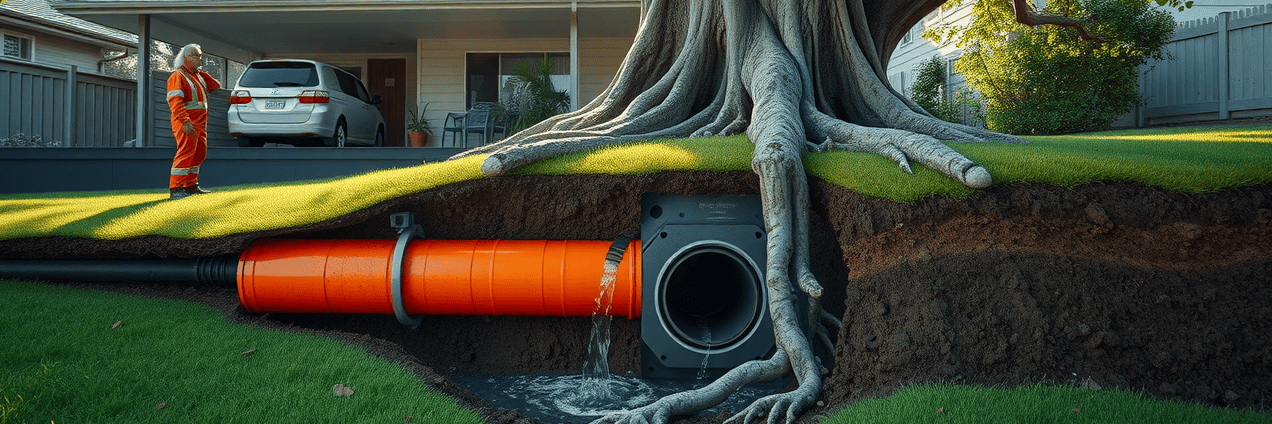Tree Roots: The #1 Cause of Blocked Drains in Sydney
Blocked drains in Sydney caused by tree roots are not just a minor nuisance—they create major disruptions to households and businesses alike. The top offender? Roots invading old Sydney sewer pipes. With the city’s mix of fragile clay drains, aging infrastructure, and leafy suburban landscapes, our plumbing system faces a unique challenge.
Tree roots naturally seek out water, and even the tiniest cracks in old terracotta pipes become entry points. Once inside, the root system quickly expands, forming dense mats that clog the sewer pipe and lead to recurring blocked drains. Many property owners only discover the problem after foul smells, slow drains, or gurgling noises—by then the root invasion has likely been developing inside the sewer line for months or even years.
With hotter summers and unpredictable weather, trees extend their root systems even further in search of moisture, making Sydney’s entire drainage system extremely vulnerable. As the sewer infrastructure ages, the number of drain pipe repairs in Sydney caused by roots continues to rise.
Taking swift action with a professional CCTV inspection is the first step. This not only restores flow but also accurately diagnoses the pipe repair or root removal services required, protecting property value and avoiding more costly plumbing problems down the track.
"Over 70% of major drain blockages in Sydney are caused by tree roots."
– Sydney Water
Signs Your Blocked Drain Is Caused by Tree Roots
Tree root invasion doesn’t happen overnight — Sydney sewer pipes usually give off clear warning signs before a total blockage occurs. If you notice any of these red flags, there’s a strong chance that invasive tree roots are already inside your sewer line:
Gurgling sounds after flushing – caused by trapped air from partial blockages and the early root growth in pipes.
Slow draining sinks, showers or toilets – especially if multiple fixtures are affected at once, pointing to a pipe blockage Sydney homeowners often face due to tree roots.
Unpleasant sewer smells indoors or outdoors – often the first sign of a crack, leak, or tree roots in sewer pipes in Sydney and across the Northern Beaches.
Recurring blockages in the same drain – roots regrow quickly if the pipe hasn’t been permanently sealed or if plumbing maintenance in Sydney is ignored.
Unusually lush or damp patches in your lawn – wastewater leaking underground from cracked pipes and tree roots and sewer lines can “fertilise” the soil.
Recognising these symptoms early is critical. They not only point to tree root intrusion but also help you avoid an emergency repair bill later. A simple CCTV drain inspection confirms the problem in minutes and shows exactly where the roots have entered.
If any of these signs sound familiar, don’t panic — this guide will show you exactly how tree roots get in, why they keep coming back, and what permanent solutions Sydney homeowners can rely on.
What You’ll Learn About Tree Roots and Sewer Lines
By the end of this guide, you’ll understand:
How tree roots actually enter Sydney drains through cracks, joints, and aging terracotta pipes — and why preventing tree root damage early is critical.
Why quick fixes like jet blasting fail — and why roots always grow back unless properly sealed with professional drain pipe repair Sydney (exact match).
The permanent solutions available for Sydney homeowners, including trenchless pipe relining and ongoing plumbing maintenance in Sydney.
The real costs of ignoring the problem — from repeated blockages to Sydney pipe damage.
How a professional CCTV inspection works and why it’s the first step in effective root invasion plumbing solutions, showing clear proof before investing in repairs.
Understanding How Tree Roots Invade Sewer Lines
The Science Behind the Invasion
The battle between Sydney’s lush trees and your underground plumbing is fought beneath the surface. As pipes age—especially common terracotta and clay pipes—tiny, hairline cracks inevitably develop. These cracks leak a small, steady stream of moisture and nutrients into the surrounding soil, creating an irresistible target for the roots of local fig, gum, and other trees.
Roots are astonishingly persistent. They can sense this trace of water from a distance and will send out ultra-fine tendrils to seek out the source. Once these tiny roots discover a weakness, they force their way through, gradually thickening over months into a tangled, destructive mass that blocks the entire pipe. This process is much faster in older sewer systems where jointed pipes, like terracotta, provide easy entry points at every single seam. A single aggressive root system can quickly catch debris and toilet paper, leading to a total blockage that requires professional root removal and repair.
The Stages of a Tree Root Invasion
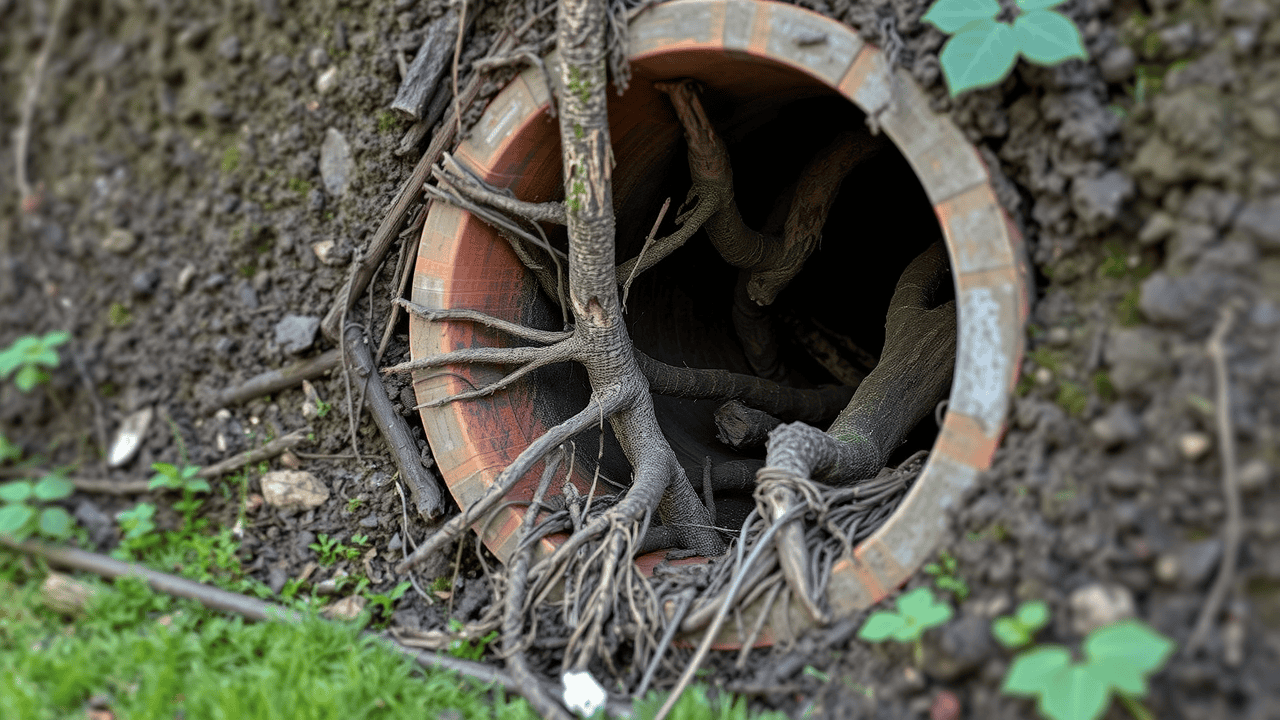
- Seeking: Roots detect moisture escaping from a tiny crack or a loose pipe joint.
- Infiltration: Fine, hair-like roots penetrate the opening.
- Growth: Once inside the nutrient-rich pipe, the roots expand rapidly, forming a dense mass.
- Blockage: The root mass grows until it completely chokes the pipe, snagging waste and causing a total blockage.
- Damage: As the roots thicken, they exert immense pressure, widening the original crack and eventually breaking the pipe.
Why Are Root-Caused Blockages So Common in Sydney?
The prevalence of blocked drains caused by roots in Sydney is due to a perfect storm of two main factors: the age of our city’s underground infrastructure and the types of pipes used in its construction.Aging Pipe Materials: Terracotta vs. PVC
Many older suburbs still rely on terracotta and clay pipes, which were the standard for sewer lines for decades. Over time, these materials become brittle and crack under pressure from shifting soil. More importantly, they are installed in short, one-metre sections, creating a joint at every metre. These thousands of joints are the primary entry points for persistent root intrusion. While modern PVC offers improved resistance with fewer joints and more flexible properties, a huge portion of Sydney’s infrastructure is still vulnerable.Sydney’s Mature Trees and Urban Landscape
The sheer number of beautiful, mature trees lining Sydney’s streets adds to the problem. As their root systems expand over decades of growth, they exert immense pressure on these aging pipes, causing cracks and leaks that attract even more roots. This is why plumbing services see a constant stream of callouts for blocked drains in areas with both old pipes and big trees—the two elements that create the perfect conditions for a recurring root problem.Which Trees Cause the Most Blocked Drains in Sydney?
Some tree species are notorious for their relentless and invasive root systems. While you might love the shade and beauty these trees provide, their roots can spell disaster for your underground sewer lines. In Sydney and the Northern Beaches, the worst offenders for tree root intrusion include:- Fig trees
- Eucalyptus (Gum) trees
- Camphor Laurel
- Jacaranda
- Poplars

"Sydney’s leafy suburbs are beautiful, but the roots of common local trees are the hidden culprits behind our city’s worst blocked drains."
– Kevin Barry, Streamline Drains & Pipelines
Discovering a Root Problem: Warning Signs of Tree Roots In Pipes
Spotting the early warning signs of tree root problem can make the difference between a straightforward fix and an expensive, disruptive excavation. But what should you look for?
The most common signs your Sydney home has a hidden pipe problem include:
Frequent gurgling sounds in drains
Slow draining sinks, showers, or toilets
Recurring backyard sogginess or foul odours
Sudden lush, green patches of grass near your sewer line
When roots force their way into the pipes, they obstruct normal water flow, causing gurgles as air escapes through the narrowed spaces. Over time, blockages worsen so that household drains take longer to clear or even back up entirely. Outdoors, you might notice wet, marshy patches where water is leaking into the soil from a broken pipe. If you observe any of these symptoms, it’s wise to engage a professional for a CCTV drain inspection before the problem escalates from a chronic blockage into a full-blown collapsed pipe.
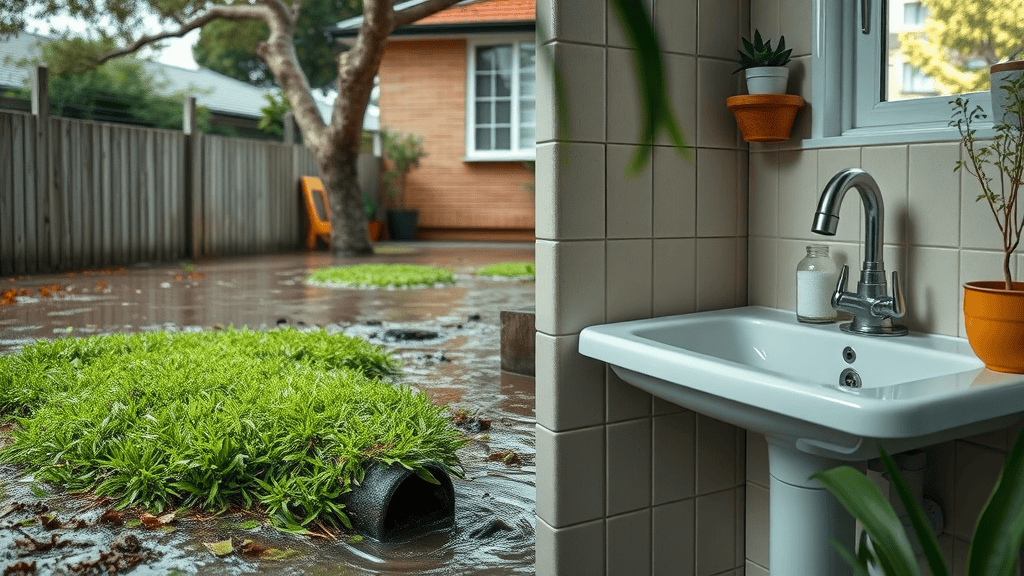
How a Camera Inspection Exposes Tree Root Problems
When and Why to Use CCTV Drain Cameras for Blocked Drains
Modern technology provides a clear window into your drains. A root intrusion detection via a specialised camera is now the industry standard for accurately diagnosing blockages. A waterproof camera is inserted into the drain, feeding real-time footage back to a monitor. This allows a technician to see exactly where roots have invaded, the extent of the root mass, and if there is structural damage that requires more than just a clean-out.
This visual confirmation saves both time and money by eliminating guesswork. It is far superior to simply running a jet blaster down the line, which might clear the blockage but misses the cause. If you’re facing recurring issues, a camera check is a non-negotiable first step, and a core part of the modern pipe relining process.
Here’s how different inspection and cleaning methods compare:
Inspection Type | Purpose | Detects Tree Roots? | Cost Range |
|---|---|---|---|
CCTV Drain Camera | Visualise blockages/pipe damage | Yes | $100-$500 |
Traditional Electric Eel | Clear minor clogs | No | $80-$150 |
Jet Blasting | Remove intruding roots | No (removes, doesn’t see) | $150-$700 |
Jet Blasting: A Quick Fix or Just a “Haircut” for Roots?
When it comes to cleaning a pipe before a permanent repair, not all methods are created equal. The choice between a modern water jet vs. an electric eel can be the difference between a temporary fix and a successful, long-lasting solution.
Jet blasting is a popular first response for clearing a blocked drain caused by tree roots. This method uses high-pressure water to cut up and flush away the root mass inside your pipes. While it often delivers rapid results, with water gushing through the previously blocked sewer line, jet blasting comes with a serious catch: it doesn’t solve the underlying problem. The cut roots quickly regrow through the same cracks and joints.
"Jet blasting clears the way for water, but unless you fix the entry point, tree root intrusion will come back again and again."
– Kevin Barry, owner Streamline Drains and Pipelines
This cycle of cutting and regrowth is why jet blasting alone is never a permanent fix. For homeowners tired of repeat plumbing service calls, the only real answer is a solution that seals the pipe completely.
Pipe Relining: The Only Lasting Answer to Tree Roots
Unlike jet blasting, pipe relining not only removes the existing tree roots but also prevents them from ever returning, offering a permanent root removal solution. By creating a seamless, jointless, and root-proof new pipe lining inside the old one, it permanently cuts off all entry points for the root system. This is a full structural rehabilitation that restores flow and extends the life of your pipes by decades.
Understanding the full value of this approach requires looking at the complete picture. The pipe relining process is a precise, multi-step technique that delivers a superior result. When you compare the one-time cost of pipe relining in Sydney against the price of repeated jet blasting, and factor in the 50-year lifespan of the repair, the long-term financial benefits become undeniable. For Sydney homeowners, it offers a much better return on investment and complete peace of mind.

Can Tree Root Barriers Prevent Blocked Drains in Sydney?
Root barriers can play a role in protecting your sewer lines, but it’s crucial to understand their limitations. These barriers are physical or chemical systems installed underground between trees and pipes to divert root growth away from vulnerable areas.
While they can be helpful, root barriers are best used as a preventative measure for new plantings, not as a guaranteed fix for existing, established trees whose roots may have already found their way around them. For mature trees, a root barrier may need to be combined with a permanent solution like pipe relining for reliable, long-term protection.
Their effectiveness depends heavily on proper placement and the age of the trees, as large, deep-rooted species can often bypass these defenses over time. For this reason, consulting with a trusted plumbing service is essential before relying on this method for protection.
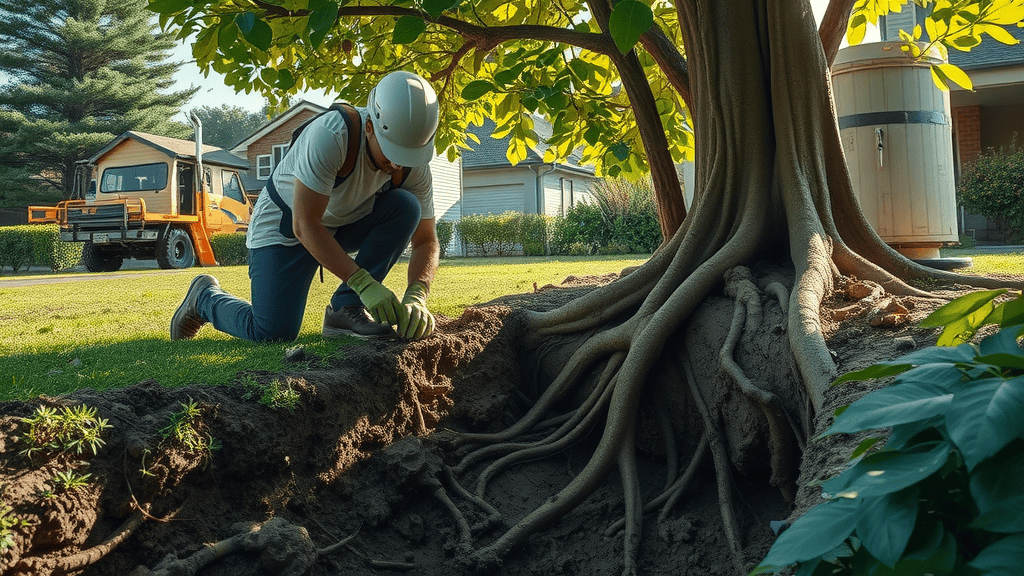
People Also Ask: Tree Root Intrusion Sydney Pipes
Q: Who is responsible for tree roots in pipes in Australia?
A: Generally, the property owner is responsible for the pipes within their boundary. If roots from a neighbour’s tree cause damage, you may have legal options, but this often requires clear proof. If the roots come from a council-owned tree, the responsibility can be more complex. A successful claim requires specific evidence, which is why we created a step-by-step guide to proving your council tree root damage claim.
Q: How do you get tree roots out of drain pipes?
A: Professionals use high-pressure jet blasting to cut and flush out root masses. However, this is only a temporary solution as the roots will regrow. For a permanent fix that seals all entry points, pipe relining is the recommended method.
Q: Does house insurance cover tree roots in pipes?
A: Most home insurance policies consider this a maintenance issue and exclude it from coverage, especially for older properties with terracotta pipes. Some policies might offer limited coverage for a sudden event like a major pipe rupture, but you must check your specific policy wording with your insurer.
Q: Who is liable for tree root damage in Australia?
A: Liability depends on property boundaries. Each owner is typically responsible for their own drainage system. If a neighbour’s tree is the cause, you may need to negotiate repairs or seek mediation. Proactive maintenance and clear communication are the best ways to resolve these issues.
Q: How fast can tree roots block a sewer line?
A: It can happen surprisingly quickly. An aggressive, fast-growing tree like a Fig or Gum can cause a significant blockage within just 6 to 12 months, especially if it finds a pre-existing crack in an old pipe.
Q: Can root intrusion actually cause a pipe to collapse?
A: Yes, absolutely. As roots penetrate small cracks, they expand and exert immense pressure over time. This pressure forces the cracks to widen, leading to pipe deformation, misalignment, and eventually, a total collapse of that section. Once this happens, the repair becomes an urgent priority.
Q: What is the cost difference between root removal and pipe relining?
A: A one-time jet blasting for root removal is cheaper upfront (around $300-$700), but the costs of repeated callouts add up quickly. Pipe relining is a larger initial investment but is far more cost-effective over time because it is a permanent, jointless solution that stops the regrowth cycle.
Q: How often should I get a CCTV drain inspection?
A: If your property has mature, high-risk trees close to your sewer pipes, a proactive inspection every one to two years is a wise investment. Early detection is the best way to prevent a minor issue from becoming a costly emergency repair.
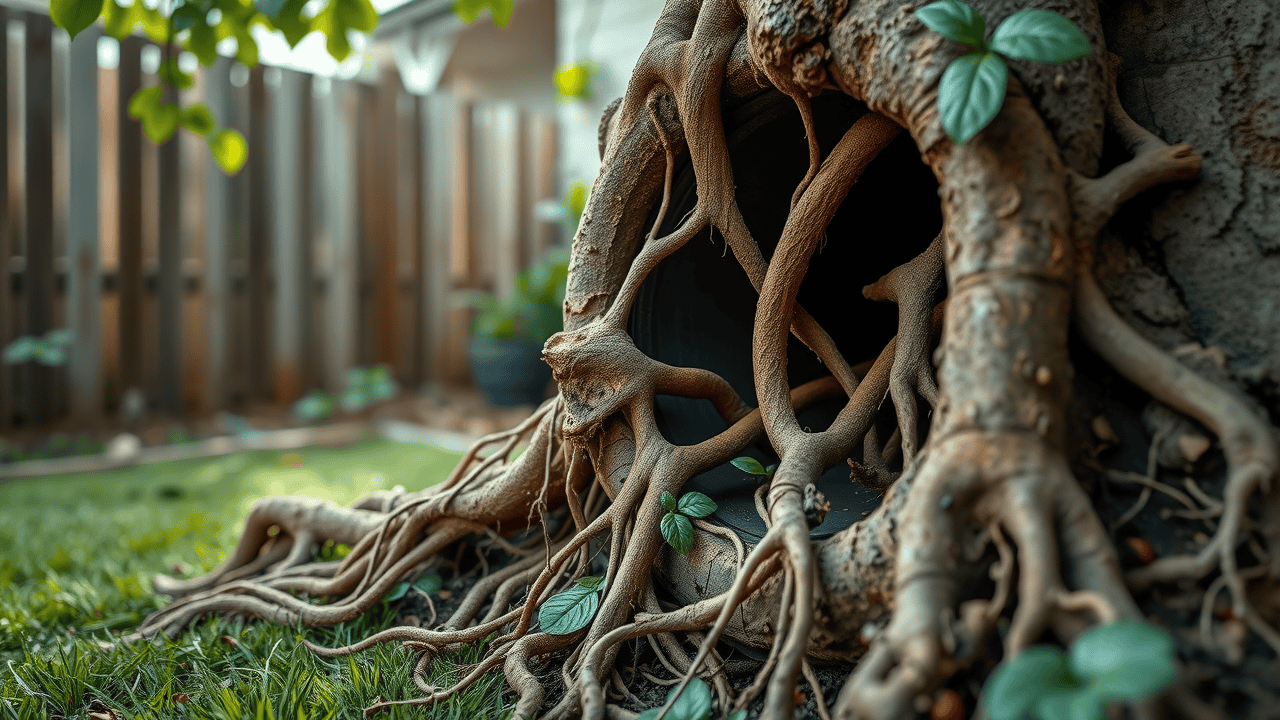
Assessing Your Situation: When to Call an Expert
Now that you understand the mechanics of tree root damage, the final step is to assess the specific situation on your property. The urgency and the best course of action can depend on the severity of the symptoms you are experiencing.
Scenario 1: You Have Early Warning Signs
If you’re noticing slow drains, occasional gurgling sounds, or a single recurring blockage, you are likely in the early stages of a root intrusion. This is the absolute best time to act. A proactive CCTV inspection can pinpoint the exact entry point and the extent of the root growth, allowing you to opt for a permanent pipe relining solution before the roots can cause any serious structural damage to the pipe itself. Acting now is the most cost-effective way to prevent a much bigger problem down the track.
Scenario 2: You Have a Serious, Recurring Problem
If you are calling a plumber to use a jet blaster on the same drain every 6-12 months, you have a significant and well-established root problem. The roots have found a reliable entry point and will continue to grow back stronger and thicker each time they are cut. At this stage, you are caught in a costly “whack-a-mole” repair cycle. The only way to break this cycle and stop wasting money on temporary fixes is to invest in a permanent, structural solution like pipe relining that seals the pipe from the inside.
Key Takeaways: How to Solve Your Tree Root Problem
Tree root invasion is the leading cause of major blocked drains in Sydney.
Older terracotta and clay pipes are the most vulnerable to root invasion at their joints.
Jet blasting is only a temporary fix; the roots will always grow back.
Pipe relining is the only permanent solution because it creates a new, seamless pipe that blocks all root entry points.
A CCTV inspection is the essential first step to accurately diagnose the problem.
Conclusion: A Permanent Solution for Your Peace of Mind
Battling the same recurring blockage every few months is a stressful and costly cycle. By understanding that tree roots are the underlying cause, you can stop paying for temporary “haircuts” and invest in a permanent solution. The bottom line is that modern pipe relining gives you the power to reclaim your pipes, protect your property, and ensure your plumbing runs smoothly for decades to come.
Everything you need to know about pipe relining is detailed in our Ultimate Guide.
Stop Tree Roots for Good: Get a Definitive Answer Today
Tired of battling tree roots every year and want to end plumbing problems permanently? Book a free CCTV inspection to see exactly where they’re getting in and how to stop them for good.

